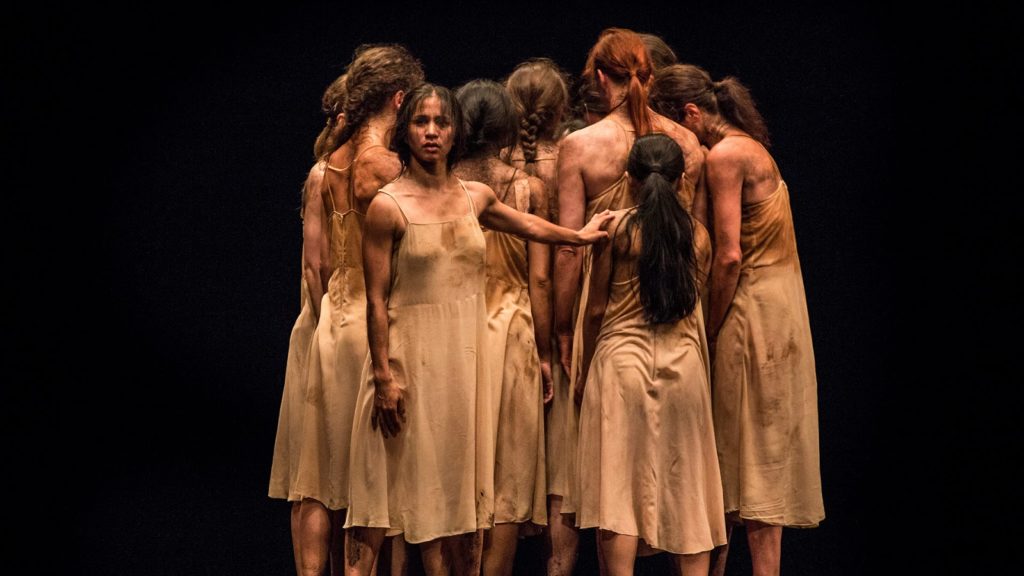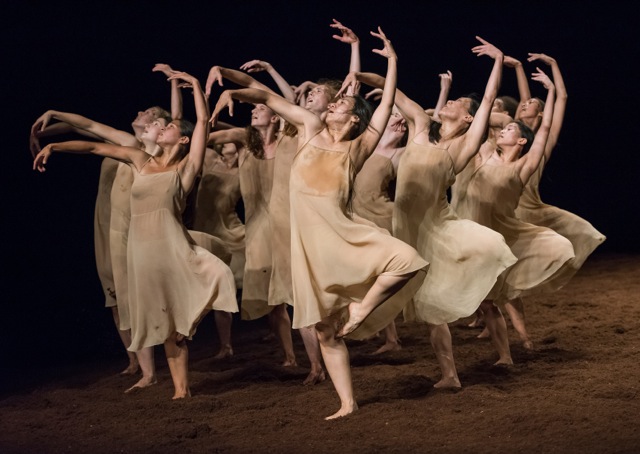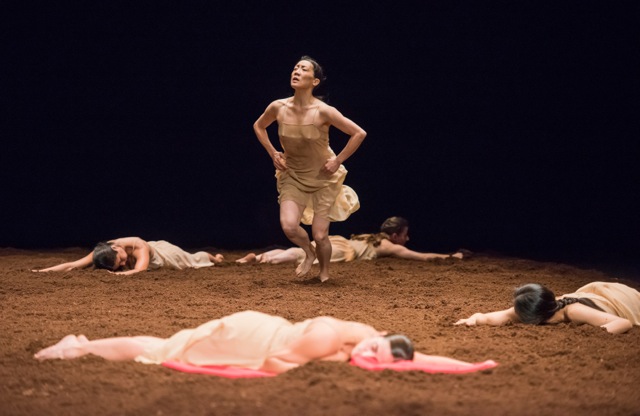The Rite of Spring Is a Work by Stravinsky Is What Kind of Art
Revisited is a series in which writers look dorsum on a work of art they first encountered long agone. Hither, Vanessa Manko revisits Pina Bausch'southward,The Rite of Spring.

Pina Bausch, The Rite of Spring, 1984. Performance view, Brooklyn Academy of Music, New York, 2017. Photo: Stephanie Berger
"Trip the light fantastic, dance otherwise nosotros are lost," Pina Bausch, the German choreographer and creative manager of Tanztheater Wuppertal, famously said. I first saw—or rather, experienced—Pina Bausch when I was an undergraduate studying away in Paris. I had trained in dance since I was vi years old, but I had recently left the ballet company I was dancing for, putting an end to what had been only the very starting time of a career. To say that I was lost because I was no longer dancing would be an understatement. I had fled to Paris to make full the gaping hole that ballet had left within me. I would learn French, study art and culture, travel, and accept in all that Paris and Europe had to offer—but all the same, I had lost my way of expressing myself, and I had not yet institute some other artistic outlet. I had no mode of dealing with the terrible grief and lassitude that followed me to Paris. "Y'all accept yourself with yous," my mother told me, wisely, before I left. All that fall and into a very cold winter, I tried to adjust to my new, chosen role as a pupil. But underneath all that, I was a brooding old ballet dancer, and I walked the boulevards of Paris trying to feel once again. I longed for the calorie-free and grace and beauty that had been, for so long, my existence. My identity had been built inside ballet's rigorous daily routines and the discipline of beginning each day in starting time position at the barre. Dancers are different creatures. They are cloistral in studios all day, rehearsing or performing tardily into the evenings, and they accept a certain predilection for perfectionism. It'south a monastic life. I found myself in civilian life feeling equally if I were one of the fallen, bandage out of ballet's mighty kingdom. "Why did y'all quit?" people asked. It was painful to hear that give-and-take, quit, the audio of it like an axe hit wood. "Information technology just wasn't working," I'd say, every bit if information technology were a divorce. But I had stopped because I wanted to become to higher, and I yearned for something more—life, cognition, food, art, books. And so, Paris.
"Yous're a dancer. Your approach to the world will e'er be through movement, through your trunk," a therapist once told me. Only I ran as far abroad as I could from trip the light fantastic toe. I took up swimming and running, and I ran straight into the life of the mind. What saved me were books and my kickoff tentative attempts at writing. It was in Paris that I had the offset inklings that I might become a author. Past the leap of that year away, I felt able to, at least, run across dance performances again. I took advantage of the student rush tickets at the Palais Garnier. Information technology was 1997 and Pina Bausch was restaging, on the Paris Opera Ballet, her 1975 masterpiece,Le sacre du printemps (The Rite of Jump). Truth exist told, I had non heard of Bausch. I was familiar with all kinds of dance genres and techniques—Graham, Cunningham, Balanchine, Cecchetti, Vaganova, Limón—simply nothing could prepare me for Pina Bausch.
On a stage covered in clay, dancers honored the advent of spring and engaged in rituals of celebration and competition. A young adult female was chosen as the sacrificial victim who must dance herself to expiry. In Bausch's rendering of The Rite of Spring, the ballet is likewise a battle of the sexes. Men and women gathered in bands, sometimes antagonistic, sometimes tender, until the necessary choosing—by fate—of the one to be sacrificed. Raw, stark, and deeply theatrical, the choreography is atavistic in its deep, pulsing pliés à la 2nd and in its darting, panicked pacing. It spoke to me on a visceral level. Here was a world far from the tame, codified globe of ballet. Instead, there was wild fearfulness, lust, despair, anger. At that place was an overall sense of ailment embedded in the music and unleashed from deep within the dancers—in the pleading achieve of limbs, the anguish of an arched back, the herdlike stamping of feet and, due to the strenuous nature of the dance, in the panting. And the clay. And so much dirt. Dirt clinging to clavicles, streaked beyond torsos and smudged, war paint–similar, along shoulders, brows, cheekbones and lips. Information technology seemed every bit if Bausch had communed with our ancient ancestors and brought all their central fury into the modern world.

Pina Bausch, The Rite of Spring, 1984. Performance view, Brooklyn University of Music, New York, 2017. Photo: Stephanie Berger
I remember leaving the Palais Garnier and walking out into the Paris night changed. I was not quite certain how I had changed, only I felt as if all the angst and unease coursing through me that entire year had sprung out from me and onto that stage. For the start time in a long fourth dimension, I felt not so lonely. Ironic, because I had just watched the chosen i dance to her death—the loneliest of positions and roles if there ever was one. Later on that night, as I tried to slumber, it was hard to shake the images of the performance from my heed. The former longtime New Yorker dance critic Arlene Croce accounted those "after images"—those moments and patterns and arrangements of bodies that banner themselves on one's mind long afterward the performance is over. The ritualistic circles, the bodies contracting and convulsing to Stravinsky's driving score, the lighter moments of frolic: they all continued to haunt me. And I saw the terror in the chosen adult female'south face, her desperation as she grabbed at the air and pulled her clenched fist to her gut, again, and again, and again. It seemed to mirror some of my own inner tumult and anguish. I was struck by her fragility and vulnerability, but likewise by her fierce strength. She seemed to be crying out and expressing loss and grief, yes, but too a hunger and a longing for more—always more—life. After seeing The Rite of Spring, I could feel again. That detail jump opened to me. The new world and path that I had called began to coalesce, and my allegiance shifted from dance to writing.
Twenty years take now passed since that spring in Paris. I have seen nearly every Pina Bausch performance at the Brooklyn University of Music—Danzón, Masurca Fogo, Nefés, Bamboo Dejection, Vollmond, to proper name a few—and was saddened by her sudden death in 2009. Those kickoff stirrings of my desire to write connected and grew into a deeper need. I went on to become a author, writing about trip the light fantastic toe and so moving on to fiction and publishing my kickoff novel. In the intervening years, I take also loved and lost friends and a parent. I have suffered through a burdensome low. I have met new friends and loves. I take seen other lives and career paths I idea were meant for me crumble every bit quickly as they took shape. And, I'g surprised to admit, I've even returned to dancing. Information technology's a more recent development, a fashion to reconnect with that erstwhile dancer self I abandoned all those years ago.
Even more recently, I saw Bausch'due south The Rite of Spring once more when the Tanztheater Wuppertal performed it in Brooklyn alongside Café Müller, the two works featured in their 1984 historic, offset performance at BAM. On opening night, September 14, 2017, the lobby was abuzz with anticipation, excitement and, beneath it all, a kind of deference. The acclaimed choreographer Marker Morris was at that place in his usual insouciant attire—shorts and sneakers. I watched as the friend I had brought with me (new to Bausch) experienced the humor and and then the horror of Café Müller'southward repetitious vignettes, which portray the chronic, recurring patterns men and women succumb to in their often futile attempts to coexist and communicate.

Pina Bausch, The Rite of Spring, 1984. Performance view, Brooklyn Academy of Music, New York, 2017. Photo: Stephanie Berger
And and then, The Rite of Spring. Here once more was the dirt, the atypical sounds of Stravinsky, the chosen i'south reddish chemise, an omen of what was to come up, and of course the dancing—the same furtive, frantic, pulsating bodies; fists clasped in unison, clutched and drawn between legs; the crashing, shuttering falls to the ground; the stops and starts; the paralyzed fear.
I eventually did find something to compare to the joy, ecstasy, and release of dancing—writing. To be able to use words to clear emotions, to depict and pin down experiences so that they are lasting and concrete, and not imperceptible like trip the light fantastic toe, affords some other kind of triumph. Simply in that location is a like sense of achievement and satisfaction in forming something out of raw materials; whether words or the body. Merely I also see that words practise accept limitations. Emotions expressed through dance still alive deep inside me, within all of us. "How would you dance if you knew you were going to die?" Bausch asked when trying to discover the right movement vocabulary for her rendition of Stravinsky's score. The answer is in this choreography. For all the writing in the earth, in that location are some experiences that live in the torso and can only be communicated through movement, gesture, dance.
Reexperiencing this piece of work was bittersweet. What, I wonder, would have happened if I had connected to dance? Maybe I would have but shed ballet and stepped into another trip the light fantastic genre—modern? Would I take come to Bausch in a different way and then, as a dancer? Is it possible that, in some parallel life, I could have been a member of her company? To sentry them dance—this dance in particular—fabricated me ache to be dancing once again. I longed to motility like that, to feel the notes of Stravinsky's dissonant score thrumming through my being, to contract and release and lunge and thrash. Information technology'due south a strange trip the light fantastic to crave to perform. It is fear and panic embodied, and also desire and despair. The motion is weighted, gritty, unhinged, and almost animalistic. It'south the very opposite of ballet with its steely grace, its ethereal and composed allure. "I loved to dance because I was scared to speak. When I was moving, I could feel," Pina Bausch has said. And through her work, she has allowed me to feel again, besides. The emotive force of her choreography has been passed down through the different generations of her dancers. It is offered upward in The Rite of Spring not and so much as a sacrifice simply equally a gift. It was a souvenir to me the first time I saw it in Paris, when I was struggling to get something other than a ballet dancer, and it was a gift to me recently, as the new person I'd come to exist. How ironic, how very humbled I was, to notice that this fourth dimension, while watching, there was nothing I longed for more than to be a dancer—again.
Vanessa Manko is the author of The Invention of Exile.
Source: https://www.theparisreview.org/blog/2017/10/11/pina-bauschs-rite-spring/
0 Response to "The Rite of Spring Is a Work by Stravinsky Is What Kind of Art"
Post a Comment